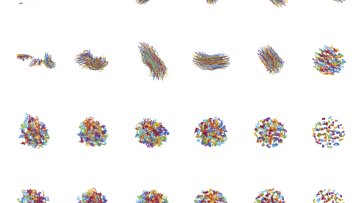Researchers from Oxford Mathematics and Imperial College London have provided a “'mathematical thought experiment' to inspire caution in biologists measuring heterogeneity in cell populations.
Generalised Summation-by-Parts Operators, Entropy Stability, and Split Forms
Abstract
High-order methods for conservation laws can be highly efficient if their stability is ensured. A suitable means mimicking estimates of the continuous level is provided by summation-by-parts (SBP) operators and the weak enforcement of boundary conditions. Recently, there has been an increasing interest in generalised SBP operators both in the finite difference and the discontinuous Galerkin spectral element framework.
However, if generalised SBP operators are used, the treatment of boundaries becomes more difficult since some properties of the continuous level are no longer mimicked discretely —interpolating the product of two functions will in general result in a value different from the product of the interpolations. Thus, desired properties such as conservation and stability are more difficult to obtain.
In this talk, the concept of generalised SBP operators and their application to entropy stable semidiscretisations will be presented. Several recent ideas extending the range of possible methods are discussed, presenting both advantages and several shortcomings.
Taxation and death may be inevitable but what about crime? It is ubiquitous and seems to have been around for as long as human beings themselves. A disease we cannot shake. However, therein lies an idea, one that Oxford Mathematician Soumya Banerjee and colleagues have used as the basis for understanding and quantifying crime.
Some Mathematical Theories of Boundary Layers with no-slip Boundary Condition
Abstract
After a brief review on the classical Prandtl system, we introduce our recent work on the well-posedness and high Reynolds numbers limit for the MHD boundary layer that shows the tangential magnetic field stabilizes the boundary layer. And then we will discuss some instability phenomena of the shear flow for both the classical Prandtl and MHD boundary layer systems. The talk includes some recent joint works with Chengjie Liu, Yaguang Wang on the classical Prandtl equation, and with Chengjie Liu and Feng Xie on the magnetohydrodynamic boundary layer.
Low algebraic dimension matrix completion
Abstract
We consider a generalization of low-rank matrix completion to the case where the data belongs to an algebraic variety, i.e., each data point is a solution to a system of polynomial equations. In this case, the original matrix is possibly high-rank, but it becomes low-rank after mapping each column to a higher dimensional space of monomial features. Many well-studied extensions of linear models, including affine subspaces and their union, can be described by a variety model. We study the sampling requirements for matrix completion under a variety model with a focus on a union of subspaces. We also propose an efficient matrix completion algorithm that minimizes a surrogate of the rank of the matrix of monomial features, which is able to recover synthetically generated data up to the predicted sampling complexity bounds. The proposed algorithm also outperforms standard low-rank matrix completion and subspace clustering techniques in experiments with real data.
OSQP: An Operator Splitting Solver for Quadratic Programs
Abstract
We develop a general purpose solver for quadratic programs based on operator splitting. We introduce a novel splitting that requires the solution of a quasi-definite linear system with the same coefficient matrix in each iteration. The resulting algorithm is very robust, and once the initial factorization is carried out, division free; it also eliminates requirements on the problem data such as positive definiteness of the objective function or linear independence of the constraint functions. Moreover, it is able to detect primal or dual infeasible problems providing infeasibility certificates. The method supports caching the factorization of the quasi-definite system and warm starting, making it efficient for solving parametrized problems arising in finance, control, and machine learning. Our open-source C implementation OSQP has a small footprint and is library-free. Numerical benchmarks on problems arising from several application domains show that OSQP is typically 10x faster than interior-point methods, especially when factorization caching or warm start is used.
This is joint work with Goran Banjac, Paul Goulart, Alberto Bemporad and Stephen Boyd
On some problems in random geometry and PDE's
Abstract
We consider a couple of problems belonging to Random Geometry, and describe some new analytical challenges they pose for planar PDE's via Beltrami equations. The talk is based on joint work with various people including K. Astala, P. Jones, A. Kupiainen, Steffen Rohde and T. Tao.




